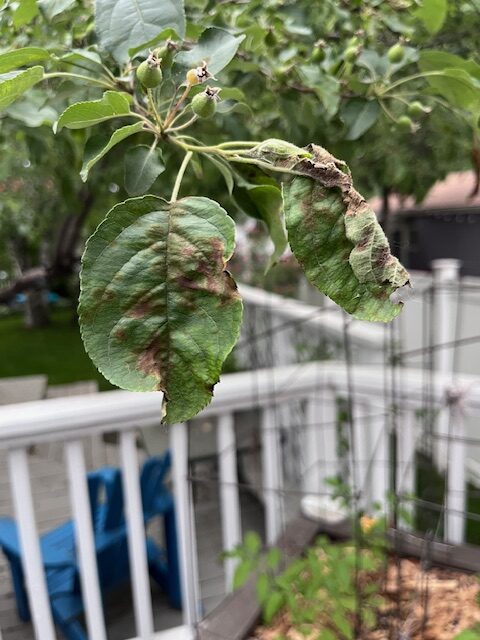Talking Plants
Jillian Patrie | University of Minnesota Yard and Garden Extension
Tree health has been a hot topic recently and with the wet start to summer, more questions will continue to roll in. What can residents be on the lookout for, and how can you determine what you are seeing is a concern or not? Let’s recap the issues that have been showing up in the FM area so far this summer.
Crabapple and fruit trees have taken the brunt of the soggy weather, leaves are turning brown, have spots and are falling off all together. Apple scab is the most common fruit tree disease, showing up on leaves and fruit of apple and crabapple trees. The leaves often have olive green to brown spots and scabs can cover the outside of the fruit. Another common fruit tree issue is a bacterial disease called fire blight. This can kill blossoms and shoots and cause branch dieback. Symptoms of fire blight include a shepherd’s hook appearance of young shoots and leaves. These shepherd hooks often appear as if they have been burnt, looking black or brown in color. Cankers can appear on branches and the trunk, which ooze a yellow-colored substance.
Managing these two diseases involves a couple methods and it is important to clean up leaf litter and dispose of it by burning, burying or composting it to help stop the spread from year to year. Fungicides will work for apple scab as a preventative measure only and need to be applied when the first leaves are emerging in spring. Make sure to sanitize any tools used to prune infected trees. Using a bleach solution after each cut will prevent spreading the diseases to other fruit trees.
Another common leaf disease we see with wet weather conditions is Anthracnose. It sounds scary, but in general it is more cosmetic than anything. Tree leaves may have spots, cupping or curling and may drop when the fungi is present. It is not recommended to treat plants for this disease and cleaning up leaf litter will help prevent the spread.
Powdery mildew will soon appear on plants such as peony, monarda (bee balm), coneflower, and in the garden on vining veggies. This is another disease that is more cosmetic than damaging, unless it is severe enough to prevent photosynthesis. Just like apple scab, fungicides can be used, but only as a preventative treatment, if you have had powdery mildew issues in the past, then spraying before you see it will keep it at bay.
Ever notice the sidewalk, your car or other surfaces are sticky in late spring to early summer? If you have an Elm, Ash or other shade trees you are likely experiencing the honeydew produced by aphids, scale and other insects that feed on leaf juices. The sticky substance is what these insects excrete as they feed. Aphids, scale, whiteflies and other sucking insects are not a big problem for outdoor plants and are less of an issue for large shade trees & shrubs. However, damage can be severe in some cases, and can warrant the use of a pesticide.
Pesticides are the last resort when it comes to controlling insects, weeds and diseases. Many outdoor plant pests do not cause enough damage to affect overall health and vigor. If a pesticide must be used, make sure to correctly identify the pest that is causing the issue before treating.
For more information on common plant pests visit: https://extension.umn.edu/solve-problem/plant-diseases If you have questions about this article or need local assistance, please contact your Clay County Extension Educator, Jill Patrie at 218-299-7338 or by email at patri350@umn.edu.


